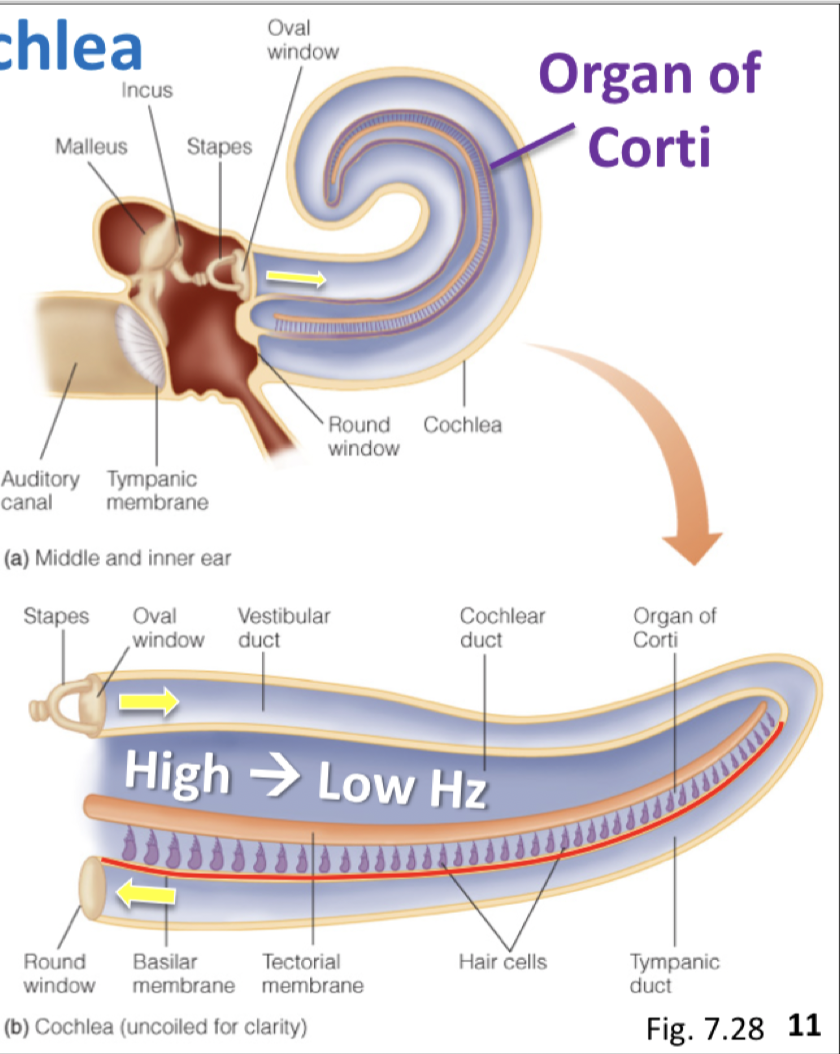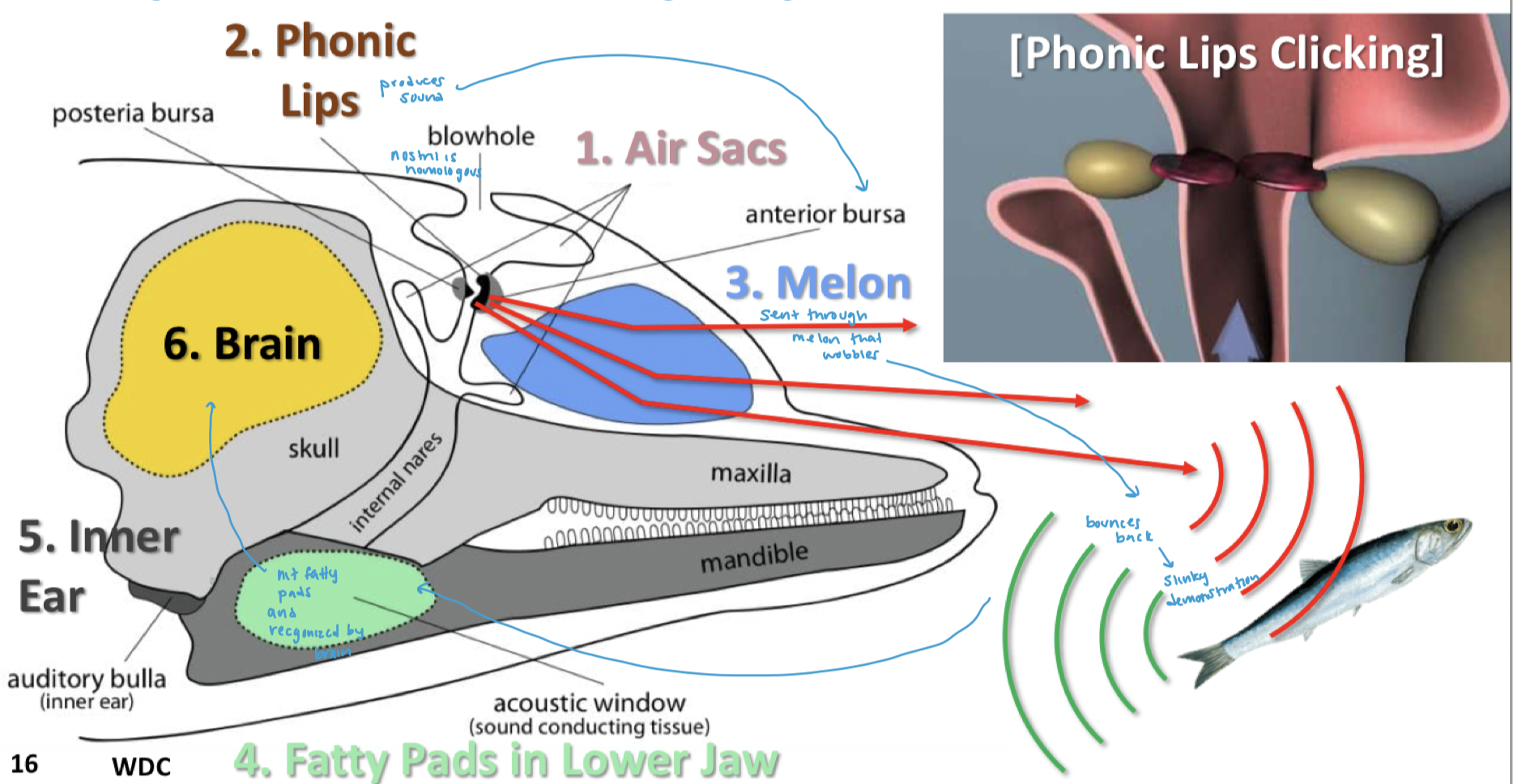Animal Sensory Systems: Mechanoreception
0.0(0)
0.0(0)
Card Sorting
1/65
Earn XP
Study Analytics
Name | Mastery | Learn | Test | Matching | Spaced |
|---|
No study sessions yet.
66 Terms
1
New cards
mechanoreception
involves physical movement
2
New cards
sensilla function
both mechanoreceptions and chemosensory
* movement of the hair stretches the transient receptor potential ion channel and opens its
* depolarization
* movement of the hair stretches the transient receptor potential ion channel and opens its
* depolarization
3
New cards
vertebrate skin and touch: how does it work?
nerve endings and corpuscles detect pressure from prolonged contact and release
4
New cards
how does mechanosignaling in hair cells work?
apical steteocilia are organized like a stair-case and directional movement of the hair opens TMC K+ channels
* pulling towards the longest hair opens the channel and depolarizes cell
* this releases NTM and triggers and action potential
* pulling towards the longest hair opens the channel and depolarizes cell
* this releases NTM and triggers and action potential
5
New cards
taut
* pulling longest hair
* depolarization
* excitory
* depolarization
* excitory
6
New cards
slack
* pushing the tallest hair
* repolarizes/hyperpolarization
* inhibitory
* closes potassium channels
* repolarizes/hyperpolarization
* inhibitory
* closes potassium channels
7
New cards
kinocilium
tallest hair-like projection
8
New cards
does the endolymph have a high or low concentration of potassium?
high concentration
9
New cards
detecting changes in water pressure in fish
the lateral line contains neuromasts (clusters of hair cells) in a cupula (gel bubble)
* when the gel vibrates from touch it moves the hair cells which stimulates an action potential
* when the gel vibrates from touch it moves the hair cells which stimulates an action potential
10
New cards
purpose of the cupula
protection of the hair cells
11
New cards
concept of distant touch
you dont need to make direct contact with the organisms
* banging on the glass of a fish tank
* banging on the glass of a fish tank
12
New cards
describe the shark lateral line
denticles and surface pores that all sea water to enter and tickle neuromasts in lateral line canal
13
New cards
C start
when pressure disturbances are heard or felt by the lateral line it startles the fish into a reflexive C start
* faces away from the stimulus
* faces away from the stimulus
14
New cards
how to tentacled snakes detect motion of prey?
mechanosensory protrusions below the nostrils
15
New cards
C start and predator arms race example
snakes predictively striking to where the fishes head will be once its startles it
16
New cards
middle ear consists of
tympanic membrane and auditory ossicles (malleus, incus and stapes)
17
New cards
tympanic membrane
thick tight drum that creates vibrations
18
New cards
purpose of the auditory ossicles
relay information to the cochlea
19
New cards
parts of the inner ear
semicircular canals, maculae and cochlea
20
New cards
semicircular canals include
ampullae
* spatial orientation
* spatial orientation
21
New cards
maculae includes
utricle
* linear acceleration
saccule
* gravity
* linear acceleration
saccule
* gravity
22
New cards
cochlea includes
lagena
* important for hearing
* non-human vertebrate name for the cochlea
* important for hearing
* non-human vertebrate name for the cochlea
23
New cards
why is bilateralism important with ears?
important for homing - detecting where the sound is coming from
24
New cards
what is the maculae?
beds of hair cells
25
New cards
how do we sense 3D spatial equilibrum and motion?
X Y and Z planes
* rotational acceleration of the endolymph pushes the cupula of the neuromast, hits the ampulla and is sensed by the hair cells
* rotational acceleration of the endolymph pushes the cupula of the neuromast, hits the ampulla and is sensed by the hair cells
26
New cards
evolution of the semicircular canals
* hagfish have 1
* lampreys have 2
* bony fish and so on have 3
* lampreys have 2
* bony fish and so on have 3
27
New cards
turning your chin to the left does what?
pressure from endolymph goes to the right which pulls the tallest have and excites the action potential
28
New cards
turning your chin to the left does what?
pressure from the endolymph does to the left which pushes the tallest hair and inhibits an action potential
29
New cards
purpose of ear stones
provide sensation of gravity and spatial orientation
* balancing
* balancing
30
New cards
what were to happen if we had magnetic ear stones?
we would have a ability to sense magnetic fields
31
New cards
what is a macula (not macuale)
bed of hair cells underlying ear stones called otoliths with a gel matrix on top to protect hair cells
* movement of otoliths vibrates gel and activates hair cells
* due to inertia
* movement of otoliths vibrates gel and activates hair cells
* due to inertia
32
New cards
utricle
located above the saccule and detects linear acceleration forces due to movement of otoliths
33
New cards
saccule
located below the utricle and detects gravity
34
New cards
difference in ear stones in vertebrates and invertebrates
vertebrates
* otoliths
invertebrates
* statoliths that are surrounded by sensory neurons (make up a statocyst)
* analogous to hair cells
* otoliths
invertebrates
* statoliths that are surrounded by sensory neurons (make up a statocyst)
* analogous to hair cells
35
New cards
where did ear bones evolve from?
jaws in fish
36
New cards
what freed the articular and quadrate?
a dentary-squamosal jaw joint
37
New cards
that quadrate turned into what?
the incus
38
New cards
the articular turned into what?
the malleus
39
New cards
where did the stapes come from?
dermal ear bone in fish
40
New cards
reptiles have how many ear bones?
one
41
New cards
mammals have how many ear bones? whats the advantage
three
* great sound amplification
* great sound amplification
42
New cards
how does mammalian hearing work with the cochlea?
* sound hits the tympanic membrane
* ear drum and middle ear bones amplify the sound the oval window
* this vibrates perilymph passes into the cochlear and bends hair cells according the loudness and frequency
* sound causes the basilar membrane to resonate and shear to distinguish pitch
* the round window prevents reverberation
* stimulation of the hair cells sends APs down cochlear nerve to brain
* ear drum and middle ear bones amplify the sound the oval window
* this vibrates perilymph passes into the cochlear and bends hair cells according the loudness and frequency
* sound causes the basilar membrane to resonate and shear to distinguish pitch
* the round window prevents reverberation
* stimulation of the hair cells sends APs down cochlear nerve to brain

43
New cards
describe the basilar membrane
stiff but not uniform and detects frequencies
* higher frequencies are stiff and lower frequencies are flexible to the membrane
* higher frequencies are stiff and lower frequencies are flexible to the membrane
44
New cards
how does the round window work?
shock absorber so sound doesnt linger
45
New cards
the cochlea is also called
the organ of corti
46
New cards
how many orders of magnitude does vertebrate hearing vary by?
four
47
New cards
humans hear approximately what range of frequencies?
20-20,000
* no infrasonic or ultrasonic
* no infrasonic or ultrasonic
48
New cards
what are the only animals that can hear infrasonic frequencies?
elephants
49
New cards
what animals can hear ultrasonic frequencies?
mouse, bat, belgua whales and dolphins
50
New cards
why do herptiles hear less than other animals?
shorter cochlea and less ear bones
51
New cards
how do animals decide to vocalize?
within their hearing range
52
New cards
insect hearing is special because?
evolved dozens of times
53
New cards
how do flies and bees hear?
detect sound vibrations by ciliated cells at the base of their antennal ears
54
New cards
where are tympanal membranes located in insects?
on any part of the cuticle
55
New cards
where do crickets and katydids have their tympana?
on their tibias
* this is where they hear
* same principle as our ears just in their legs
but they have modified breathing tubes called acoustic trachea to carry the sound
* this is where they hear
* same principle as our ears just in their legs
but they have modified breathing tubes called acoustic trachea to carry the sound
56
New cards
echolocation is
navigating through the dark
57
New cards
two examples of echolocation we discussed
big brown bat
* use acoustic mapping to hunt in the dark
toothed whales
* air passed through phonic lips produced clicking noises for acoustic mapping and melon contorts that sound to adjust it
* melon processes
* use acoustic mapping to hunt in the dark
toothed whales
* air passed through phonic lips produced clicking noises for acoustic mapping and melon contorts that sound to adjust it
* melon processes
58
New cards
acoustic mapping
phonic lips make loud and rapid chirps that bounce off items and are bounced back to the organisms to give them a sense of direction
* bilaterialism is important
* bilaterialism is important
59
New cards
compare sound travel in and out of water
5x faster in water
60
New cards
how is the dolphin cranial anatomy specialized for echolocation?
* air sacs trigger phonic lips in blow hole and send sound out into environment
* sound passes through melon and jiggles is
* sound bounces on things in environment
* then it its the fatty pads and is recognized by the brain which is where it is processed
* sound passes through melon and jiggles is
* sound bounces on things in environment
* then it its the fatty pads and is recognized by the brain which is where it is processed
61
New cards
where are the fatty pads located?
the lower jaw
62
New cards
the blowhole is a homologous evolution of what?
the nostrils

63
New cards
what are hearing aids for bony fish?
swim bladders
* gas-filled balloon reacts to sound waves because when the air sac vibrates
* webarian ossicles sense the movement of the swim bladder and relay information to the inner ear
* gas-filled balloon reacts to sound waves because when the air sac vibrates
* webarian ossicles sense the movement of the swim bladder and relay information to the inner ear
64
New cards
otocephalans include
herring, minnows, catfish and piranha
* they all have connection from the bladder to the inner ears
* they all have connection from the bladder to the inner ears
65
New cards
benefit of weberian ossicles
they increase hearing sensitivity
66
New cards
examples of specialized acoustic communication
ultra-rapid contractions of sonic muscle fibers produce sound
* tail of rattlesnake
* tymbal of cicada
* swim bladder of toadfish
* tail of rattlesnake
* tymbal of cicada
* swim bladder of toadfish